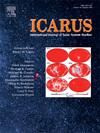Saturn satellite Hyperion: Morphology of its impact craters based on results of NASA mission Cassini
IF 2.5
2区 物理与天体物理
Q2 ASTRONOMY & ASTROPHYSICS
引用次数: 0
Abstract
Hyperion, a satellite of Saturn, has a shape which can be approximated by the triaxial ellipsoid with axes of 355, 257, and 213 km. Here its surface morphology, geology, composition, and some issues of its origin are described based on images taken by the Cassini Visible and Infrared Mapping Spectrometer and other data obtained during the mission. The surface of this body is densely populated with impact craters with diameters from less than a few kilometers to 20–30 km. High depth/diameter ratios (∼0.3) probably being due to the high porosity of the Hyperion material are characteristic of these craters. Another notable feature of many Hyperion craters is the presence of rectilinear parts of their rims, imparting polygonal shapes to the craters. These shapes are probably due to simultaneous impacts forming neighboring craters and to presence of fractures/faults in the body material. On Hyperion, a large 200 × 250 km crater is present. Its depth is ∼35 km and it has a central peak ∼100 km in diameter and ∼ 5–7 km high above the floor level. Hyperion surface materials are characterized by two major types: the dominant one is visually light and composed mostly of H2O ice, while the subordinate one is visually dark and showing spectral signatures of hydrocarbons. Hyperion probably is a captured body arrived from more distant areas of the solar system.
求助全文
约1分钟内获得全文
求助全文
来源期刊

Icarus
地学天文-天文与天体物理
CiteScore
6.30
自引率
18.80%
发文量
356
审稿时长
2-4 weeks
期刊介绍:
Icarus is devoted to the publication of original contributions in the field of Solar System studies. Manuscripts reporting the results of new research - observational, experimental, or theoretical - concerning the astronomy, geology, meteorology, physics, chemistry, biology, and other scientific aspects of our Solar System or extrasolar systems are welcome. The journal generally does not publish papers devoted exclusively to the Sun, the Earth, celestial mechanics, meteoritics, or astrophysics. Icarus does not publish papers that provide "improved" versions of Bode''s law, or other numerical relations, without a sound physical basis. Icarus does not publish meeting announcements or general notices. Reviews, historical papers, and manuscripts describing spacecraft instrumentation may be considered, but only with prior approval of the editor. An entire issue of the journal is occasionally devoted to a single subject, usually arising from a conference on the same topic. The language of publication is English. American or British usage is accepted, but not a mixture of these.
 求助内容:
求助内容: 应助结果提醒方式:
应助结果提醒方式:


